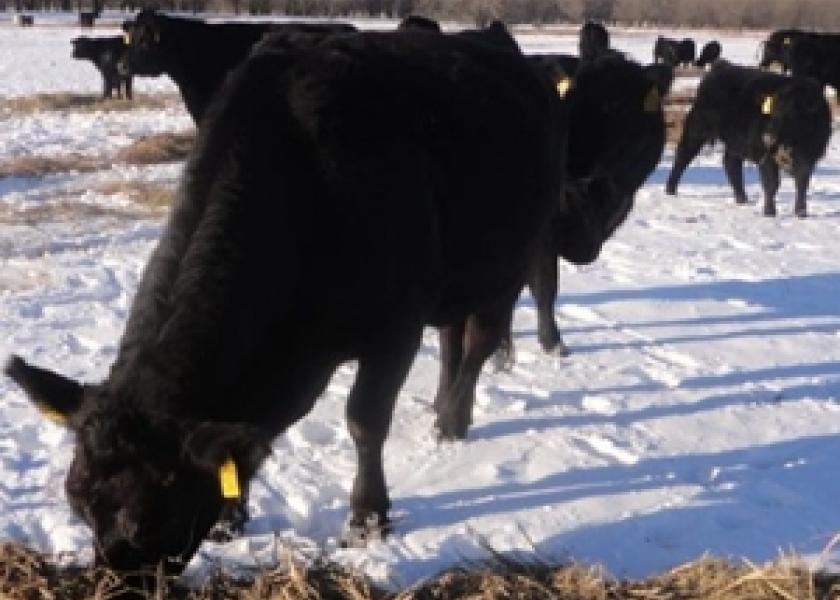Cow Herd Nutritional Adjustments for Winter

By: Katie Allen, K-State Research & Extension News
High daily temperatures at 20 and 30 degrees confirm the arrival of winter. A week or more of cold temperatures, particularly below freezing, can take a toll on the cow herd. A bodily response to cold stress in cattle is an increase in dry matter intake, said Dale Blasi, professor and beef cattle extension specialist for Kansas State University.
Blasi recommends that cattle producers, if they haven’t already, make a list of the forages they have available for the winter months, know the quality of those forages, take a look at the body condition and hair coat condition of each cow, and prepare for winter winds by providing shelters or windbreaks for the herd.
Forage testing can help determine the quality of the forages producers have on hand, Blasi said. During a string of days with sub-freezing temperatures, the higher quality forages should be used to increase the herd’s caloric intake, but producers should keep in mind that, depending on the harshness of winter, increased animal requirements might continue well into spring.
"Especially with those spring-calving cows, they are starting to enter into their third phase of gestation," Blasi said. "We have to make sure we keep those pregnancies as healthy as possible."
If producers are feeding a co-product such as distillers dried grain, Blasi said, they would provide some additional protein and fat to the cows. Providing more corn to the herd is fine to a certain level.
"You get too much corn into the diet, you start to impact the rumen’s ecosystem, and you start to hurt the fiber digesting capability of the lower-quality forages being consumed," Blasi said. "My recommendation is not more than a half of a percent of the animal’s weight. So, a 1,000-lb. cow you would not feed more than 5 lbs. (of additional corn). Make sure there is adequate protein coming elsewhere so you’re not driving a protein-limiting ecosystem."
Body condition and hair coat
Assessing the body condition and hair coat for each cow in the herd can help producers determine how much more energy requirements are needed in the winter months. According to a K-State Research and Extension publication, body condition scores are numbers used to suggest the relative fatness or body condition of the beef cow. The score system ranges from 1 to 9, with 1 representing a very thin cow and 9 representing an extremely fat cow.
If a cow currently has a body condition score of less than 5, Blasi said, she might be at a health risk for the winter. Furthermore, her low body condition might compromise the health of the calf she is carrying. The effects from a hard winter on that cow could last into the spring, as she might lack in the quality of her first milk for the calf and the ability to breed back in a timely manner.
Blasi recommends that producers separate the herd by body condition scores, so the cows with less flesh can be supplemented with more nutrients. Also, younger and likely smaller females should be watched closely.
"We are hopefully going through a herd rebuilding now, and a lot of folks have some optimism for the future," Blasi said. "If at all possible, split the herd up by the age and also the body condition. Monitor, evaluate and be mindful that you can slip a lot of body condition over periods of time when it is wet, windy and cold."
All cows should have a winter coat by now, Blasi said, but when cows are wet from snow or cold rain, their coats become matted and their insulation breaks down.
Prior research at Kansas State showed that the critical temperature for a cow with a summer coat or wet coat is 60 degrees Fahrenheit (60 F). It is 45 F for cows with a fall coat, 32 F for those with a winter coat and 19 F for those with a heavy winter coat.
Be strategic
Wind chill, based on temperature and wind speed, can make cattle even more compromised, Blasi said. With temperatures at freezing and winds at more than 10 mph, cows could need a 15 to 20 percent increase in forage requirements.
"The amount of hair will help those females combat the impact of wind chill," Blasi said. "But, as she starts to shiver, an increase in maintenance requirements ensue."
While many producers have turned their cows out on grazing stocks—sorghum and corn—they have to keep in mind that many of those crop fields don’t have places for the cows to keep out of the cold wind. Blasi said that a windbreak can provide up to a 70 percent reduction in wind velocity and can change the wind chill from -5 F to 7 F, a 12-degree swing.
"Any kind of shelter is a tremendous step forward for helping them withstand and coast over these inclement weather events," Blasi said.
If cows are grazing stocks, producers might consider supplementing those stocks on extremely cold days, Blasi said. Producers might also want to strategize when they feed hay and any supplements.
"A well-known phenomenon with feeding pregnant beef cows is that feeding them in the afternoon and evening hours has a corresponding effect on calving in daylight hours," Blasi said. "Obviously, when we’re expecting babies coming, it’s nice to be there if the cows should need help. Feeding in the evening also increases the heat of fermentation for the cow as we see these nighttime lows."
K-State Research and Extension’s Beef Cow Nutrition Guide includes more information about winter cow diets and supplements producers can consider for use.







